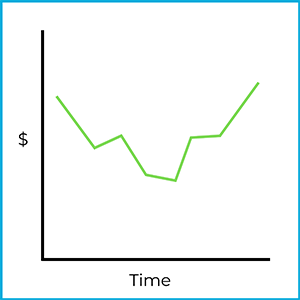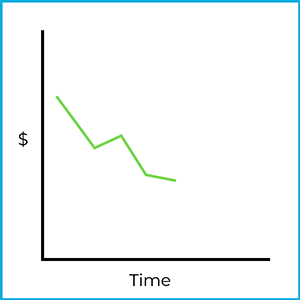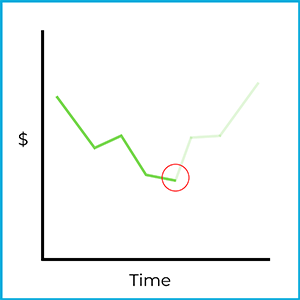In the previous sub chapter, you learned about fundamental analysis, which involves inspecting company finances. We’re now shifting into a different type of analysis.
Technical analysis involves identifying and predicting trends in the stock market. Technical analysts typically pay little-to-no attention to the fundamentals of a company (e.g. expenses, revenues, etc.). They’re more concerned with finding predictable stock price patterns and betting on those patterns occurring again.
Fundamental and technical analysis are two different approaches to evaluating investments.
Fundamental analysis focuses on what to buy by examining a company’s financial health and economic conditions. Investors look at factors like earnings, revenue, price-to-earnings (P/E) ratio, dividends, and balance sheets to determine a stock’s intrinsic value. This method is often used by long-term investors who want to find undervalued companies with strong growth potential. For example, an investor might buy a stock because it has consistent earnings growth and a low P/E ratio compared to its industry.
Technical analysis focuses on when to buy by analyzing price trends, charts, and market patterns. It relies on predictable stock price patterns since history tends to repeat itself in the market. This method is mostly used by short-term traders but can also be used for the long term, looking to capitalize on price fluctuations. For instance, a trader might buy a stock because it has broken above a key resistance level, signaling potential upward momentum.
It’s important to understand that fundamental analysis helps determine whether a stock is a good investment based on financial data, while technical analysis is used to time market entries and exits based on trends. Many investors use both methods together for a well-rounded strategy.
Technical analysts believe history repeats itself in the market. To better understand this, let’s look at a stock chart:

While this may look like a basic stock chart, a technical analyst would identify this as a unique formation. Specifically, this is a head and shoulders bottom formation, which we will learn more about later in this subchapter. While the stock’s market movement already played out with the chart above, it could be used to predict where the stock price goes in the future. For example, what if a few days later the same stock started fluctuating like this:

While there’s no promise the market price will move in the same direction, there is some evidence of repeating market trends in the real world. If this stock follows the same trajectory as it did previously, a purchase at this point would be profitable:

Again, the market is unpredictable and could easily go the other way. Technical analysis is a prediction tool, but not all predictions come true. It takes a fair amount of chart analysis to find these trends, which is why technical analysts are sometimes referred to as “chartists” (chart artists).
In this subchapter, we’ll explore various ways technical analysts interpret and use market data to make investment decisions.
Sign up for free to take 3 quiz questions on this topic